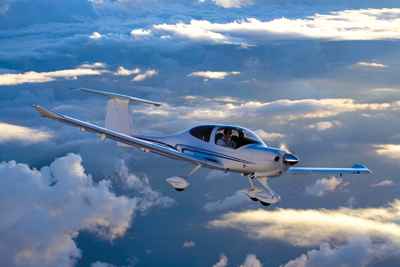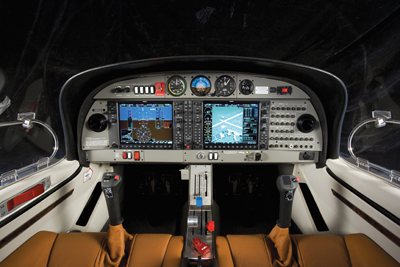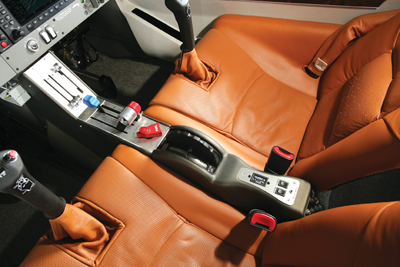
Features
Aircraft
DA40 XLS Gets Superman Vision
Who would have thought a few years ago that an early partnership with Garmin and constant airframe refinements would accelerate the Diamond DA40 to the quintessence of private aviation?
September 29, 2009 By Ken Armstrong
Who would have thought a few years ago that an early partnership with Garmin and constant airframe refinements would accelerate the Diamond DA40 to the quintessence of private aviation? The earliest installation of the Garmin 1000 system helped catapult the DA40 to the forefront of four-place aircraft. In fact, Diamond’s 2009 Q1 piston aircraft sales eclipsed Cirrus, and would have even beat out Cessna if it weren’t for that company’s addition of the Cessna 400 (nee Columbia) to its product line in 2007.
 |
|
| Powered by the 180 hp Lycoming IO-360-M1A, the DA40 cruises at 150 ktas at 75 per cent while sipping only 10 gallons per hour of fuel.
|
Enter la pièce de résistance. The DA40 XLS is the first aircraft to boast the new Garmin Synthetic Vision Technology (SVT), an avionics upgrade that provides Superman-like vision regardless of weather phenomena. Using geographical terrain data stored in the 1000’s Terrain Awareness and Warning System (TAWS), the Primary Flight Display (PFD) screen shows the topography ahead of the aircraft, helping the pilot to overcome spatial disorientation and avoid flights into terrain. The vertical real estate is coloured to show relative clearance heights, and whereas an infrared detector system provides night vision for $80,000 or more, the synthetic vision system “sees” the terrain all the time – regardless of weather – day or night! And it does this for only an extra $10,000 added to the aircraft price.
Greatly enhancing situational awareness and thus safety, this equipment displays transponder-equipped traffic behind mountains, antennas poking up into clouds and of course the ability to see yourself taxiing on an airport diagram with buildings clearly visible thanks to input from the TAWS database. The SVT also provides guidance images called “Pathways” that provide the “highways in the sky” typically found in high-end turbine aircraft. When coupled with the Garmin GFC 700 autopilot, the combination increases awareness and reduces workload, allowing pilots to conduct approaches in a manner only advanced business aircraft or airliners could accomplish in the past.
 |
|
| The WAAS certified Garmin G1000 glass cockpit uses two 10-inch screens, with traffic, weather, terrain and chart information including Safetaxi.
|
I was given the opportunity to fly the DA40 XLS and used the chance to tour beautiful Southern Ontario. Prior to arriving at the Diamond Aircraft factory in London, Ont., I reviewed the Garmin 1000 training manual and then utilized the factory training console to get back up to speed on a system that can provide prodigious data at a keystroke – sometimes more than my six-decades-old central processor can evaluate. Still, more is better….Very little re-familiarization of the DA40 was needed as it is as easy to fly as the commonly mentioned Cessna 172 – and the DA40 boasts an unchallenged safety record to prove it. Mind you, for a fair comparison on the DA40’s performance, one should consider the Cessna 182 and Cirrus SR20.
The aircraft I flew for the evaluation was a loaded XLS version tipping the scales at 1,798 pounds, leaving 847 pounds for a useful load. Long range tanks of 50 US gallons left 547 pounds for pilot, passengers and baggage. (A nice touch is that the aft seats fold flat to provide a sleeping area or stowage for lots of gear.)
Directional control on the ground in the DA40 is via differential braking and a swivelling nose wheel and input from the rudder once underway. In the hot and humid conditions, I taxied with the canopy in the locked and slightly open position for plenty of ventilation. All checks were straightforward and I was airborne in less than 1,000 feet with a direct crosswind on published limits and an initial climb rate of 1,000 feet per minute with an OAT of 30 C. I found seat comfort, vibration attenuation, visibility and sound levels very reasonable and attributed the quieter and smoother cabin to the new three-bladed scimitar propeller and low drag powerflow exhaust modifications.
 |
|
| The DA40 XLS comes standard with a stylish leather interior and modern features such as electrically adjustable rudder pedals allowing pilots of differing sizes to fit comfortably in the cockpit.
|
In a rush? The XLS can produce 158 KTAS at 2,000 feet – but, it will cost 17 US gallons per hour. Conversely, I flew one leg of my trip at 21square (manifold pressure and rpm) and yielded 115 KTAS on 6.2 gallons per hour at 6,000 feet. At the same altitude, many pilots might opt for 23 square for a fuel flow of eight gallons per hour and 135 KTAS. At 75 per cent power the fuel flow creeps up to 10 gallons per hour while clipping along at 150 KTAS. Depending on power setting, the range will vary from 720 to 785 nm with a 45 minute reserve. At the other end of the speed spectrum, I learned the power off, full flap stall gently arrives at 49 knots. In between these speed extremes the control harmony was delightful and the electric trim was just the right speed to eliminate any stick forces.
So, what’s next? Just when I thought the DA40 cannot be improved upon, I learned that Diamond has been working on a diesel version with a four-point engine mount and much smoother, powerful and more miserly fuel consumption than previous diesels. Quite frankly, I wish there was a need for a DA40 in my business or personal life, because the value inherent in the design makes it very attractive. Moreover, the manufactured and serviced in Canada attributes provide purchasing ease and suggest superior support with no over-the-border hassles. Diamond has truly brought innovation and safety back down to earth.